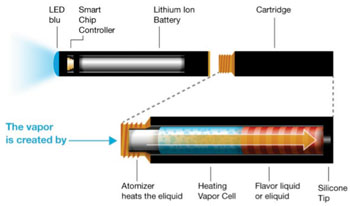E-cigarettes Contain Multiple Carcinogens
By HospiMedica International staff writers
Posted on 11 Dec 2014
A new study reveals that e-cigarettes can contain up to 10 times the level of cancer-causing agents than regular tobacco, including formaldehyde and acetaldehyde.Posted on 11 Dec 2014
Researchers at the at Japanese National Institute of Public Health (Saitama, Japan) analyzed 13 cartridges of e-cigarette fluid using a smoking machine that "inhaled" 10 sets of 15 puffs. A range of hazardous compounds were found in the e-cigarettes, particularly carbonyl compounds such as formaldehyde, acetaldehyde, acetone, acrolein, propanal, crotonaldehyde, butanal, glyoxal, and methylglyoxal. The carbonyl compounds are generated by the vaporization of the e-liquid when it contacts with the heated nickel-chromium (nichrome) atomizer.

Image: Inside an Electronic cigarette (Photo courtesy of Blu e-cigarette).
The researchers found that the results of the smoking machine tests varied, depending on the type of e-liquid in the cartridge, the compositions and concentrations of the compounds, and the battery voltage of the atomizer. One brand, the name of which was not revealed, showed a more than 10-fold level of formaldehyde on 9 out of every 10 sets. Another brand showed similar levels on several sets, but was not consistently that high. The study was published on October 28, 2014, in the International Journal of Environmental Research and Public Health.
“Very high amounts of formaldehyde were measured. Glyoxal and methylglyoxal, which show mutagenicity, are specific to e-cigarette aerosols and have been minimally detected in the mainstream smoke from traditional cigarettes,” concluded senior author Prof. Naoki Kunugita, MD, PhD, and colleagues. “The amount of carbonyl compounds in these brands of e-cigarettes varied significantly not only among different brands but also among different samples of the same products. However, in most cases, the levels are lower than those in tobacco cigarette smoke.”
Nicotine e-cigarettes, or electronic nicotine delivery systems (ENDS), were first developed by Herbert A. Gilbert, who patented a device described as “a smokeless non-tobacco cigarette” that involved “replacing burning tobacco and paper with heated, moist, flavored air” in 1963. However, the invention of the modern e-cigarette in 2003 is attributed to Hon Lik, a Chinese pharmacist, who introduced them to the Chinese market as a smoking cessation device in 2004.
Related Links:
Japanese National Institute of Public Health














